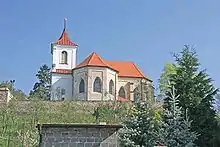Sadská
Sadská (Czech pronunciation: [ˈsat.skaː]) is a town in Nymburk District in the Central Bohemian Region of the Czech Republic. It has about 3,200 inhabitants.
Sadská | |
|---|---|
 Southern part of Sadská | |
 Flag  Coat of arms | |
 Sadská Location in the Czech Republic | |
| Coordinates: 50°8′21″N 14°58′56″E | |
| Country | |
| Region | Central Bohemian |
| District | Nymburk |
| First mentioned | 993 |
| Government | |
| • Mayor | Milan Dokoupil |
| Area | |
| • Total | 16.44 km2 (6.35 sq mi) |
| Elevation | 185 m (607 ft) |
| Population (2023-01-01)[1] | |
| • Total | 3,235 |
| • Density | 200/km2 (510/sq mi) |
| Time zone | UTC+1 (CET) |
| • Summer (DST) | UTC+2 (CEST) |
| Postal code | 289 12 |
| Website | www |
Geography

Sadská is located about 6 kilometres (4 mi) southwest of Nymburk and 30 km (19 mi) east of Prague. It lies in the Central Elbe Table lowland within the Polabí region. The highest point of the municipal territory is a hill in the centre of the town with an altitude of 215 m (705 ft). The Šembera River flows southeast of the town, and the Elbe forms short part of the northern municipal border. In the northern part of the territory there is Sadská Lake, which was created by flooding a sand quarry.
History
The first written mention of Sadská is in the foundation document of the Břevnov Monastery from 993. A royal castle was built on a hill above the town to protect the country road. In 1118–1120, Duke Bořivoj II had built the Church of Saint Apollinaris with a chapter. Until the mid-13th century, monarchs used to go to Sadská for entertainment and hunting. In 1262, the seat was moved to Poděbrady, only the chapter remained. A hundred years later, Charles IV transferred the chapter to New Town of Prague, and the golden times of Sadská came to an end.[2]
A convent was founded here, but it was burned down during the Hussite Wars. A new propsperity began in 1562, when Sadská was promoted to a market town by Ferdinand I. During the 17th century, the castle disappeared as a result of the Thirty Years' War and several large fires. In 1784, Sadská was promoted to a town by Joseph II.[2]
Demographics
|
|
| ||||||||||||||||||||||||||||||||||||||||||||||||||||||
| Source: Censuses[3][4] | ||||||||||||||||||||||||||||||||||||||||||||||||||||||||
Transport
The D11 motorway runs south of the town.
Sights

The landmark of the town is the Church of Saint Appolinaris on a hill above the town. It was rebuilt to its current form by Kilian Ignaz Dientzenhofer in 1737–1739, and modified in 1894–1895.[5]
The Chapel of Our Lady of Sorrows was built next to a spring of healing water in 1714–1721, and probably was also rebuilt by Dientzenhofer.[5]
The Baroque bell tower dates from 1691. Originally it was a clock tower.[5]
Notable people
- Franz Xaver Niemetschek (1766–1849), philosopher and music critic
- Václav Marek (1908–1994), writer, traveller, publicist and researcher
References
- "Population of Municipalities – 1 January 2023". Czech Statistical Office. 2023-05-23.
- "Historie města" (in Czech). Město Sadská. Retrieved 2022-08-23.
- "Historický lexikon obcí České republiky 1869–2011 – Okres Nymburk" (in Czech). Czech Statistical Office. 2015-12-21. pp. 9–10.
- "Population Census 2021: Population by sex". Public Database. Czech Statistical Office. 2021-03-27.
- "Umělecké památky" (in Czech). Město Sadská. Retrieved 2022-08-23.